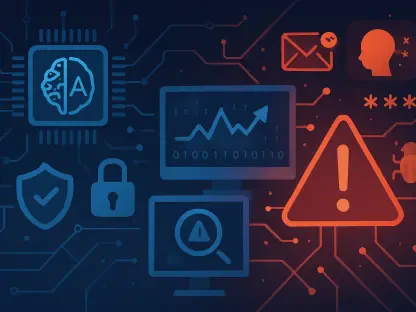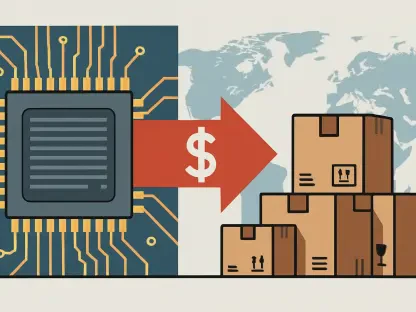The rapidly evolving global technology landscape presents Chief Information Officers (CIOs) with a complex maze of geopolitical, cultural, and regulatory challenges. This complexity is reshaping digital strategies and demanding a nuanced approach to leadership that increasingly straddles the roles of strategic visionary and tactical executor. As CIOs step into these multifaceted roles, the singularity of a one-size-fits-all strategy has become obsolete. They must instead adopt and execute region-specific approaches that consider diverse regulatory landscapes, political climates, and cultural influences. This transformation is driven by the realization that effective digital leadership necessitates a broadened understanding of local and global contexts and an adaptable mindset responsive to rapid technological advancements and shifting socio-political climates.
Reshaping Global Digital Strategies
Understanding Geopolitical Dynamics
In an interconnected world, technological advancements march in lockstep with global politics, influencing strategies and decisions at every level of digital leadership. The stark reality that technology cannot exist in a vacuum is more evident than ever, and CIOs must adeptly navigate geopolitical currents to safeguard their organizations’ interests. Political tensions, such as those arising from conflicts between major powers or within regions themselves, directly impact risk assessments and strategic initiatives. Geopolitical instability influences everything from supply chain strategies to cybersecurity protocols, compelling technology leaders to proactively incorporate global political developments into their digital roadmaps. Awareness and adaptation are crucial, enabling organizations to safeguard their operations and capitalize on emerging opportunities within shifting geopolitical frameworks.
Technology export controls, which can abruptly change the playing field for companies operating across borders, are another crucial area demanding attention. CIOs must stay informed about the evolving sanctions landscape and shifting compliance requirements that impact their operations and partnerships. Understanding these dynamics is essential not only to ensure compliance but also to leverage opportunities in the global market. Moreover, the establishment and enforcement of data sovereignty rules increasingly dictate where data can reside and move, further underlining the necessity for CIOs to design infrastructure and data management strategies that align with these laws while maintaining agility and resilience. Balancing compliance with regulations and seizing market opportunities remains a key juggling act for tech leaders.
The Role of Regional Regulatory Differences
The regulatory landscape presents an equally formidable arena, with regional differences shaping the contours of digital transformation across diverse territories. In particular, European Union initiatives like the General Data Protection Regulation (GDPR) and the subsequent Digital Services Act (DSA) continue to influence global standards, encouraging adoption and adaptation of similar frameworks worldwide. This regulatory environment elevates the importance of data management, privacy, and operational transparency for technology companies, challenging CIOs to rethink traditional models and adapt new protocols ensuring compliance and resilience. Simultaneously, these regulations also prompt organizations to future-proof their strategies by aligning with jurisdictions that promote open and innovative digital economies.
Such European initiatives have prompted a broader global response, underscoring the need for CIOs to engage in ongoing strategic assessment to evaluate emerging regional compliance requirements. As other regions devise their regulatory frameworks, such as the United Kingdom with its Data Protection and Digital Information Bill, it is essential for CIOs to keenly monitor these developments. Not only do they have to ensure their organizations comply with these regulations, but they must also seek opportunities for alignment and synergy with broader market access strategies. As the regulatory environment diversifies, organizations that can balance agility and compliance will be well-positioned to thrive amidst these complexities.
Embracing Cultural Dynamics
Aligning Technology with Cultural Norms
Cultural dynamics play a pivotal role in shaping business operations, and understanding these intricacies is key to formulating successful technology strategies across regions. Consumer expectations, workforce norms, and public opinions regarding technology vary significantly from one geographical context to another. This diversity necessitates a tailored approach, where cultural understanding informs strategic planning and execution. Technology leaders must recognize and embrace these differences to respond effectively to local demands and harness opportunities unique to each region.
Navigating workforce norms, particularly in relation to automation and remote work, is critical for CIOs as they strive for operational excellence. Public perceptions of these shifts differ widely across cultures, demanding a nuanced approach to manage change and foster acceptance through strategic communication and thoughtful implementation. By considering cultural attitudes towards technology and work-life balance, CIOs can better facilitate smooth transitions and cultivate an engaged, motivated workforce. Combining technological strategies with cultural awareness ultimately supports sustainable growth and organizational resilience, equipping businesses to emerge as leaders within their respective markets.
Cultural dynamics also influence the integration of public-private initiatives, expediting digital transformation on a broader societal scale. Partnerships between the government and industry stakeholders, when culturally resonant, can create robust infrastructures that support technological advancement and societal progress. By fostering collaboration and communication between public and private entities, CIOs can facilitate the creation of ecosystems where innovation thrives and local communities are empowered through shared benefits. Recognizing these cultural cues can help create opportunities for impactful collaborations that drive meaningful change.
Navigating Workforce Expectations
In today’s global technology landscape, workforce expectations and dynamics are critical considerations for technology leaders. Traditional work models are being redefined by innovations, automation, and the growing adoption of hybrid work environments. CIOs must navigate these expectations, balancing efficiency gains with employee satisfaction and productivity. A contagious wave of remote work has prompted organizations to rethink team dynamics and collaboration models, overcoming geographical barriers to assemble diverse, tech-savvy talent pools. Yet, this requires deft management of cultural differences, as work preferences and norms can vary dramatically between regions.
The balance between automation and human oversight is also at the forefront of workforce expectations, as companies integrate innovative technologies like Artificial Intelligence and machine learning into their operations. Employees may express concerns about automation’s impact on job security and expectations around upskilling and career development. CIOs must carefully articulate the vision and rationale behind technological initiatives, integrating employee feedback and fostering dialogue across all levels of the organization. This approach ensures a harmonious alignment between technological transformation, human capability development, and business outcomes.
Further, tech-savvy talent pools are increasingly looking for employers that resonate with their values, championing transparency, diversity, and sustainability in their policies. In this regard, CIOs and CTOs play a leading role in aligning their organization’s mission with these values, resulting in compelling narratives for prospective employees. Addressing these workforce dynamics is crucial to ensuring that organizations remain innovative, agile, and competitive amid the ever-changing global business environment. Effective management of these expectations fosters an engaged and loyal workforce, which in turn supports long-term organizational success.
Regional Insights
Europe’s Regulatory Landscape
Europe is a region where regulatory frameworks continually influence the digital strategies of CIOs and CTOs. The European Union’s regulatory arm is renowned for spearheading initiatives like GDPR and more recently, the Digital Services Act, introducing comprehensive policies for data privacy, cybersecurity, and content moderation. These initiatives underscore Europe’s commitment to creating a secure, transparent digital landscape and have sent ripples across global markets, encouraging other regions to adopt similar measures. As a consequence, compliance with European standards has become an imperative for technology leaders worldwide, as it ensures not only adherence to regulations but also consistency and trust across digital ecosystems.
With the geopolitical landscape in flux, particularly in light of the war in Ukraine, the emphasis on cybersecurity measures in Europe has gained significant momentum. Organizations must prioritize safeguarding critical data and infrastructure, necessitating resilient digital strategies. Additionally, the rising focus on sustainability adds another layer of complexity, compelling businesses to incorporate environmentally conscious practices in the design and operationalization of their digital strategies. As environmental regulations tighten, companies that prioritize sustainability will build goodwill among stakeholders and future-proof their operations in this dynamic regulatory environment.
Evidently, the European regulatory landscape is highly influential, leading organizations to often orient global strategies according to EU standards, ensuring ease of compliance across multiple jurisdictions. European CIOs and CTOs are therefore tasked with the careful navigation of compliance obstacles while steering their organizations toward robust growth and innovation. By aligning strategies with these regulatory frameworks, technology leaders can harness opportunities for sustainable success in the region and beyond.
Middle East’s Digital Evolution
The Middle East showcases an evolving digital frontier, with nations actively investing in technological advancement and diversification of their economies, aspiring to become regional and global tech hubs. The United Arab Emirates and Saudi Arabia, in particular, have taken proactive measures to embrace digital transformation by investing in cutting-edge technologies, infrastructure projects, and visionary initiatives that drive economic and social growth. These nations endeavor to leverage technology as a key enabler for achieving national agendas, spurring transformative growth across sectors and fostering innovation.
The region’s focus on smart infrastructure and digital investments entails significant opportunities for collaboration and partnership across borders. With smart cities and innovative tech solutions being central to national strategies, the Middle East is poised to become an attractive destination for technology investments and ventures. Technology leaders must navigate this ecosystem to capitalize on emerging opportunities and build established, robust networks that align with national development goals.
However, the evolving socio-political landscape and regional conflicts present additional challenges and complexities in executing digital strategies. Infrastructure stability, data governance, and risk management become paramount considerations for CIOs and CTOs to ensure success in these dynamic environments. Building partnerships and robust frameworks that balance innovation with risk mitigation will prove essential for entities looking to play a significant role in this evolving landscape. Leveraging the Middle East’s digital evolution offers organizations immense potential to establish resilience and embed their competitiveness in the region’s technological trajectory.
Strategic Opportunities and Challenges
The United States’ Tech Sector Dynamics
In the United States, digital leaders continue to navigate a highly dynamic environment driven by technological advancements, labor market trends, and evolving trade policies. The commercialization of Artificial Intelligence and machine learning has gained significant relevance in driving innovation and competitiveness across industries. Companies are rapidly adopting AI to streamline operations, enhance customer experiences, and foster decision-making agility. To harness these opportunities, CIOs must articulate clear use cases and align AI initiatives with overall business objectives, ensuring long-term value creation and strengthening competitive advantage.
The U.S. tech sector also faces labor market challenges intensified by rapid technology adoption and supply chain disruptions exacerbated by global events such as trade tensions and pandemic-related uncertainties. As organizations grapple with workforce scarcity and shifts in talent expectations, technology leaders must explore innovative strategies to address these dynamics and maintain productivity. Techniques such as automation, reskilling, and flexible work policies can empower organizations to stay ahead but require careful calibration to ensure alignment with organizational goals.
Amidst these dynamics, shifting public policies, including revisions to remote work regulations, government procurement strategies, and trade agreements, present opportunities and challenges for U.S. technology leaders. Public sector austerity measures influence vendor landscapes and resource allocations, specifically in terms of talent acquisition and technology investments. Cognizant of these factors, CIOs must adopt adaptive strategies capable of navigating complex industrial landscapes, ensuring business continuity and success amidst evolving public policies.
Asia’s Innovation and Fragmentation
Asia remains a hotbed of innovation, witnessing meteoric advancements in technology and an ever-evolving economic landscape. Countries in the region are trailblazing developments in Artificial Intelligence, fintech, and smart city solutions, driven by robust tech ecosystems and a burgeoning talent pool. As a result, Asia presents a dynamic technological environment offering substantial growth opportunities for technology leaders who can align their strategies with regional innovations, leveraging unique insights to inform digital transformation initiatives.
At the same time, Asia’s fragmentation is notable, dictated by varying political systems, regulatory models, and cultural dynamics. As U.S.-China tensions and India-Pakistan conflicts shape the region’s geopolitical landscape, companies face heightened infrastructural challenges and techno-economic considerations. This necessitates CIOs to maneuver adeptly through these complexities to enhance their digital preparedness, mitigate risks, and ensure seamless operations. Strategic investments in supply chain resilience, regional partnership development, and political risk analysis are critical for building resilience and streamlining operations.
Emerging regulatory frameworks across Asia further accentuate the need for technology leaders to embed context-specific considerations in digital strategies. As regional developments unfold, CIOs must decipher the regulatory puzzles and localize adaptation efforts to comply with evolving standards. Balancing these elements empowers organizations to maintain market agility, seize growth opportunities, and secure success in the fast-paced Asian technological sphere.
Dynamic Digital Transformation Insights
In today’s interconnected world, technological progress is deeply intertwined with global politics, affecting strategies and decisions at all levels of digital leadership. The interconnectedness of technology and politics is more apparent than ever, forcing CIOs to skillfully navigate geopolitical forces to protect their organizations’ interests. Political tensions, whether from conflicts between major powers or regional disputes, have a direct impact on risk assessments and strategic initiatives. This instability affects everything from supply chain strategies to cybersecurity measures, urging tech leaders to proactively factor global political changes into their digital strategies. Being aware and adaptable is crucial for organizations to protect their operations and seize new opportunities in shifting geopolitical landscapes.
Export controls on technology, which can alter the landscape for companies operating internationally, require close attention. CIOs must be up-to-date on the changing sanctions and compliance rules that affect operations and partnerships. Understanding these dynamics is critical not just for compliance, but also to exploit opportunities in the global market. Additionally, the enforcement of data sovereignty rules dictates where data can be stored and transferred, highlighting the need for CIOs to develop infrastructure and data management strategies that comply with these laws while remaining agile and resilient. Balancing regulatory compliance with seizing market opportunities is a key challenge for tech leaders.









